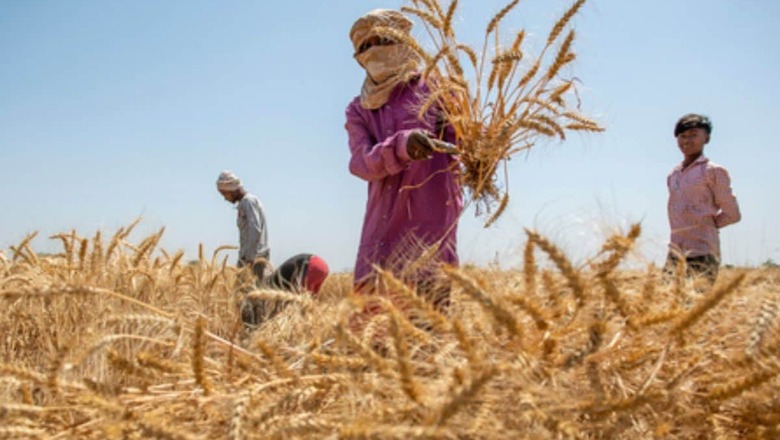
views
Indian agriculture, dominated by over 80% of smallholder farmers, is inherently vulnerable to risks arising from increasing climate change. In addition, increasing extreme weather events are adversely impacting the crop production conditions in the country.
According to India’s Third National Communication submitted to the UN Framework Convention on Climate Change (UNFCCC) in December 2023, around 156 districts are prone to high frequency of droughts, 91 districts prone to cyclones and 61 districts to floods, while 271 districts to rise in minimum temperatures. In this regard, recent studies suggest that without adoption of suitable climate change adaptation measures, productivity of major crops is projected to fall significantly in the coming decades. For instance, yields of rain-fed rice and wheat are projected to fall by about 20% and 19.3% respectively by 2050, as per the press release from the Ministry of Agriculture and Farmers Welfare on December 4, 2023.
In addition, India has become the most populous country in the world in 2023 with 1.43 billion people surpassing China and is expected to reach around 1.5 billion by 2030, as per the estimates of UN population Division. India needs to ensure food security of more than 17% of world’s population with about 2.4% and 4% of world’s land and water resources respectively. In this context, Adaptation Gap Report 2023 by United Nations Environment Programme (UNEP) indicates that about USD 16 billion adaptation investment in agriculture per year would prevent starvation and hunger of about 78 million people. Under such scenario, there is an urgent need to scale up finance for climate change adaptation of Indian agriculture with necessary policy measures for not only ensuring future food security but also for safeguarding the income and livelihoods of smallholder farmers.
Globally, climate finance flows to agriculture and allied sectors are significantly lower compared to energy and transportation sectors. The annual flow of funds to Agriculture, Forestry and Land Use (AFOLU) sector stood at about $17.8 billion, accounting for only 1.9% of total global climate finance flows in 2020-21, according to the T20 Policy Brief on Financing Climate-Smart Agriculture for Sustainable Agri-Food Systems, published in July 2023. The actual annual flows to AFOLU are only a fraction of the required funds at $423 billion per year up to 2030. Moreover, the flow funds to AFOLU actually declined from around $21 billion in 2017-18 to $17.8 billion in 2020-21.
Further, the allocation and flow of funds to adaptation actions are much lower than that of mitigation. The adaptation finance for agriculture and food sector stands much lower at $7.4 billion per year compared to mitigation finance at $14.4 billion per year as per the report on Landscape of Climate Finance for Agrifood Systems, published by Climate Policy Initiative (CPI) in July 2023. A further cause for concern is the drastic reduction in finance for small-scale agriculture food systems by 44% to $5.5 billion per year in 2019-20 compared to that in 2017-18 as per The Climate Finance Gap for Small-Scale Agrifood Systems published by CPI in November 2023.
In India, the cumulative requirement of adaptation finance for agriculture is estimated at around Rs. 85 lakh crore according to the Report on Currency and Finance 2022-23 Towards a Greener Cleaner India by the Reserve Bank of India (RBI). There are no comprehensive estimates available for tracking the actual flow of funds to agriculture, particularly for adaptation. However, a partially tracked estimate of finance for adaptation covering disaster, monitoring, and emergency response system, flood mitigation and drought management sectors stood at about Rs 36,000 crore per year during 2019-20 as per the Landscape of Green Finance in India 2022 by CPI. On the other hand, the National Adaptation Fund for Climate Change (NAFCC), established in 2015 to support adaptation activities in the country, has spent about Rs 847 crore so far according to the fund’s implementing agency, National Bank for Agriculture and Rural Development (NABARD). In India, only public sector funding has been the major source of funding for adaptation in agriculture so far and it is time to mobilise finances from private sector.
Thus, there is an urgent need to fill the substantial funding gap in finance for climate change adaptation in agriculture in order to ensure not only the future food security of the country’s vast population but also to enhance incomes and protect livelihoods of farmers. It is essential to prioritise funding for climate change adaptation, especially considering the long time period required for the development and field testing of suitable agricultural technologies, climate change resilient crop varieties and cultivation practices.
In order to meet the substantial requirement of funding for adaptation, it is essential to judiciously use all the finance sources including public and private sectors. Towards this, there is an urgent need to devise the requisite policy strategies and measures to mobilise finance for climate change adaptation in Indian agriculture from private sources along with public sector sources.
Dr A Amarender Reddy is Joint Director, School of Crop Health Policy Support Research (SCHPSR), ICAR-National Institute of Biotic Stress Management (ICAR-NIBSM), Raipur. Dr Tulsi Lingareddy is Senior Economist, Financial Markets, Sustainable Finance and Agriculture. Views expressed in the above piece are personal and solely that of the author. They do not necessarily reflect News18’s views.




















Comments
0 comment